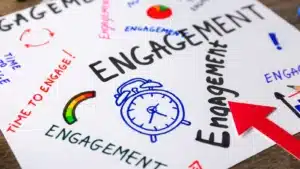
From Notes to Action: Writing Impactful Icebreaker Questions For Work
Understanding the Importance of Icebreaker Questions
Icebreaker questions serve as a vital tool in fostering communication and connection among team members in a workplace setting. They help to ease tension, stimulate conversation, and encourage collaboration. When strategically crafted, these questions can break down barriers and pave the way for a more cohesive work environment.
In a world where remote work and hybrid models are becoming increasingly common, the need for effective icebreakers is more pronounced than ever. They not only help initiate conversations but also build relationships that can lead to enhanced teamwork and productivity. For instance, when team members feel comfortable sharing their thoughts and ideas, they are more likely to contribute creatively and collaboratively, which can significantly benefit project outcomes.
The Role of Ice Breakers in Team Dynamics
Icebreakers are particularly useful in various scenarios, such as team meetings, workshops, or onboarding sessions. They can help to:
- Establish rapport among team members.
- Encourage participation and engagement.
- Foster a culture of openness and trust.
By incorporating icebreaker questions into these settings, organizations can create an environment where employees feel valued and connected, ultimately leading to better collaboration. Furthermore, the positive effects of these interactions can extend beyond the immediate context; team members who bond over icebreakers are more likely to support each other in challenging situations, enhancing overall morale and job satisfaction.
Types of Ice Breaker Questions
Icebreaker questions can be categorized into several types, each serving a different purpose. Understanding these categories can help in selecting the most appropriate questions for a given situation:
- Fun and Light-hearted: These questions aim to lighten the mood and create a relaxed atmosphere. For example, asking team members about their favorite childhood cartoon can spark laughter and nostalgia, making everyone feel more at ease.
- Personal and Reflective: These questions encourage team members to share personal experiences or insights, fostering deeper connections. Questions like “What is a book that has significantly influenced your life?” can lead to meaningful discussions that reveal shared values and interests.
- Work-related: These questions focus on work experiences and challenges, promoting professional dialogue. Asking, “What has been your biggest learning experience at work?” can not only provide valuable insights but also inspire others to share their own stories of growth.
By thoughtfully selecting icebreaker questions from these categories, facilitators can tailor the conversation to suit the group’s dynamics, ensuring that everyone feels included and engaged. This intentional approach can transform a simple meeting into an opportunity for genuine connection and collaboration, setting a positive tone for the tasks ahead.
Crafting Effective Ice Breaker Questions
Writing impactful icebreaker questions requires careful consideration of the audience, context, and desired outcomes. Here are some key strategies to keep in mind:
Know Your Audience
Understanding the demographics and personalities of the team members is crucial. Tailoring questions to suit the audience can significantly enhance engagement. For instance, a group of creative professionals may respond better to imaginative questions, while a team of engineers might appreciate more technical or analytical prompts. Additionally, consider the cultural backgrounds of your participants; what might be a fun or light-hearted question in one culture could be perceived differently in another. This awareness can help you craft questions that resonate positively with everyone involved, fostering a sense of inclusivity and comfort.
Keep It Simple and Clear
Complex or ambiguous questions can lead to confusion and disengagement. Aim for clarity and simplicity in your questions. A well-structured question should be easy to understand and answer, allowing participants to focus on sharing their thoughts rather than deciphering the question itself. Moreover, using familiar language and avoiding jargon can make your questions more accessible. This is especially important in diverse groups where varying levels of expertise and familiarity with specific terms may exist. A straightforward approach not only encourages participation but also sets a welcoming tone for the discussion.
Encourage Open-ended Responses
Open-ended questions facilitate richer discussions and allow participants to express themselves more fully. Instead of asking questions that can be answered with a simple ‘yes’ or ‘no,’ frame them in a way that invites elaboration. For example, instead of asking, “Do you like coffee?” consider asking, “What’s your favorite coffee drink and why?” This not only encourages storytelling but also helps participants connect over shared experiences and preferences. Additionally, consider incorporating follow-up prompts that can guide the conversation deeper, such as, “How did you first discover that coffee drink?” or “What memories does it evoke for you?” Such layers can transform a simple icebreaker into a meaningful exchange that builds rapport among team members.
Examples of Impactful Ice Breaker Questions
Here are some examples of icebreaker questions that can be utilized in various workplace settings:
Fun and Light-hearted Questions
- If you could have any superpower, what would it be and why?
- What’s the most unusual food you’ve ever tried?
- If you were a character in a movie, who would you be and why?
These fun and light-hearted questions serve as a great way to ease tension and foster a sense of camaraderie among team members. They encourage creativity and humor, allowing individuals to express their personalities in a relaxed environment. For instance, discussing superpowers can spark imaginative conversations about how those abilities could be used in everyday life, leading to laughter and shared stories. Similarly, sharing unusual food experiences can open up discussions about cultural backgrounds and culinary adventures, which can be both entertaining and enlightening.
Personal and Reflective Questions
- What’s a book that has significantly impacted your life?
- Can you share a memorable experience from your childhood?
- What’s a personal goal you’re currently working towards?
Personal and reflective questions delve deeper into individual experiences and values, promoting a more profound understanding among colleagues. When team members share impactful books, it can lead to discussions about different perspectives and philosophies, enriching the workplace culture. Childhood memories often evoke nostalgia and can reveal shared experiences that strengthen bonds. Moreover, discussing personal goals not only encourages accountability but also opens avenues for support and collaboration, as colleagues may find common interests or ways to assist each other in achieving their aspirations.
Work-related Questions
- What project are you most proud of and why?
- What’s a challenge you’ve faced in your career, and how did you overcome it?
- If you could change one thing about your job, what would it be?
Work-related questions focus on professional experiences and aspirations, fostering a sense of shared purpose and teamwork. By discussing proud projects, employees can celebrate their achievements and inspire others with their success stories. Sharing challenges faced in their careers not only highlights resilience but also builds trust among team members, as vulnerability can lead to stronger connections. Furthermore, contemplating changes they would make to their jobs can spark constructive conversations about workplace improvements and innovation, ultimately contributing to a more engaged and motivated team environment.
Implementing Ice Breaker Questions in Meetings
Incorporating icebreaker questions into meetings can significantly enhance the overall experience for participants. Here are some tips on how to effectively implement these questions:
Timing and Placement
Choosing the right moment to introduce an icebreaker is crucial. Typically, it’s best to start the meeting with an icebreaker to set a positive tone. This can help participants feel more comfortable and engaged right from the beginning. Additionally, consider the context of the meeting; for example, if it’s a particularly serious or high-stakes meeting, a light-hearted icebreaker can help alleviate tension and foster a more collaborative atmosphere.
Facilitating Participation
Encouraging everyone to participate is key to the success of icebreaker questions. Consider using techniques such as:
- Going around the room or virtual meeting space, allowing each person to answer.
- Using breakout rooms for smaller group discussions.
- Incorporating anonymous polling for larger groups.
Moreover, it’s beneficial to tailor the ice breaker questions to the group’s dynamics and the meeting’s objectives. For instance, if the meeting involves a team that has been working together for a while, questions that delve into personal interests or experiences can strengthen bonds. Conversely, for newly formed teams, questions that focus on professional aspirations or skills can help participants identify common ground and build rapport.
Creating a Safe Environment
To foster openness, it’s essential to create a safe environment where participants feel comfortable sharing. Leaders should model vulnerability by sharing their own answers and emphasizing that there are no right or wrong responses. Additionally, it can be helpful to establish ground rules for the ice breaker session, such as respecting each other’s privacy and opinions, which can further enhance the sense of safety. This practice not only encourages participation but also cultivates a culture of trust and respect within the team, paving the way for more fruitful discussions throughout the meeting.
Evaluating the Effectiveness of Ice Breaker Questions
After implementing icebreaker questions, it’s important to assess their effectiveness. Here are some strategies to evaluate their impact:
Gathering Feedback

Soliciting feedback from participants can provide valuable insights into the effectiveness of the icebreaker questions. Consider using anonymous surveys or direct conversations to gather thoughts on what worked well and what could be improved. Additionally, you might want to include specific questions that gauge how participants felt about the atmosphere created by the icebreakers. Did they feel more comfortable sharing their thoughts afterward? Were they able to connect with others in a meaningful way? These insights can help refine your approach and ensure that future sessions are even more engaging.
Observing Engagement Levels
Pay attention to the level of engagement during the icebreaker segment. Are participants actively contributing, or do they seem disengaged? High levels of interaction can indicate that the questions were effective, while low engagement may suggest a need for adjustment. It can also be beneficial to observe non-verbal cues, such as body language and facial expressions, as these can provide additional context about how participants are feeling. Are they smiling and leaning in, or are they crossing their arms and looking away? Such observations can offer a deeper understanding of the overall impact of the ice breakers on group dynamics.
Adjusting for Future Sessions
Based on feedback and observations, be prepared to adjust your approach for future sessions. Experimenting with different types of questions and formats can help find the right balance that resonates with your team. For example, consider incorporating themed icebreakers that align with specific goals or projects. This not only makes the activity more relevant but also encourages participants to think creatively about their responses. Furthermore, varying the format, such as using small group discussions or interactive activities, can cater to different personality types and preferences, fostering a more inclusive environment.
Overcoming Common Challenges
While icebreaker questions can be highly effective, they may also present certain challenges. Here are some common issues and strategies for overcoming them:
Dealing with Shyness or Reluctance
Some team members may feel shy or reluctant to participate in icebreaker activities. To address this, consider using less intimidating questions or providing options for individuals to share their thoughts in writing before speaking. This can help ease anxiety and encourage participation. Additionally, creating a supportive atmosphere where everyone feels valued can significantly reduce feelings of shyness. Encouraging team leaders to model vulnerability by sharing their own experiences can also foster a sense of community and openness, making it easier for others to join in.
Managing Time Constraints
In fast-paced work environments, time constraints can limit the opportunity for icebreakers. To manage this, select shorter questions or limit the number of participants who respond. This ensures that the ice breaker segment remains concise while still achieving its purpose. Alternatively, consider integrating icebreakers into existing meetings or team-building activities, allowing for a seamless transition that maximizes engagement without requiring additional time. This approach not only saves time but also reinforces team cohesion by blending fun with productivity.
Avoiding Repetition
Repeated questions can lead to disengagement over time. Keep a rotating list of icebreaker questions to maintain freshness and interest. Regularly updating the questions can also help to reflect the evolving dynamics of the team. To further enhance engagement, involve team members in the creation of new questions. This not only gives them a sense of ownership but also ensures that the questions resonate with the group’s interests and experiences. Consider categorizing questions by themes, such as personal interests, work experiences, or hypothetical scenarios, to keep the conversations diverse and stimulating.
Start with the Right Question
The right ice breaker can do more than warm up a room—it can ignite connection, build trust, and shape a more collaborative culture. By tailoring prompts to your team and context, you turn small talk into meaningful engagement. PresEngage provides the tools and strategies to make every question count—boosting morale, sparking participation, and setting the stage for high-impact meetings. Start free with a 14-day trial.
Present Smarter. Engage Answer Convert Close Remarkably.
Dazzle your audience with Real-Time Q&A powered by your AI Co-Presenter.(Patent Pending)
PresEngage™ makes you look brilliant by connecting with everyone, instantly.
No Credit Card Required. 100% Risk Free.
Frictionless Audience Experience GUARANTEED.






